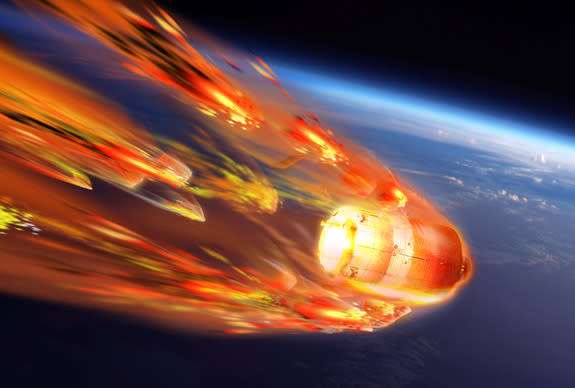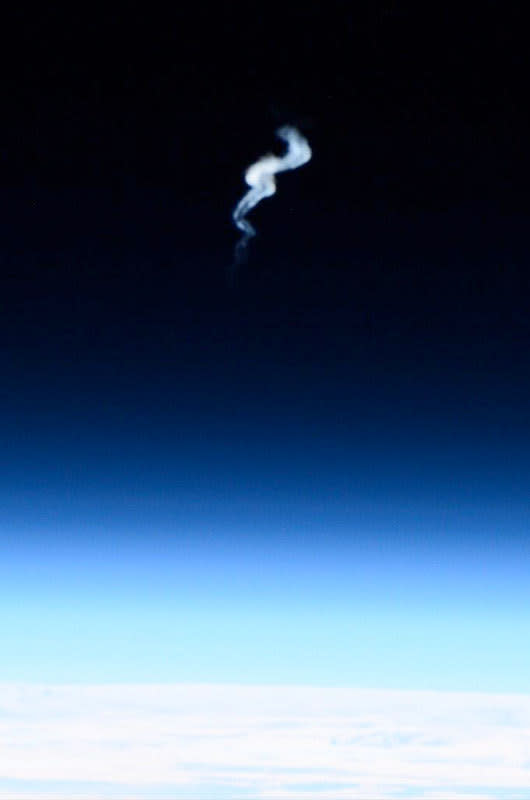Europe's Last ATV Space Station Freighter Makes Fleet's Final Re-Entry
In the end, Europe's fifth and final space station freighter went out in more of a fiery blaze than with the "big bang" of its namesake.
The European Space Agency's (ESA) Automated Transfer Vehicle (ATV) 5, christened the "Georges Lemaître" after the Belgian priest and astronomer whose work led to the Big Bang theory of the universe's origin, was intentionally destroyed as it plunged back into the Earth's atmosphere on Sunday (Feb. 15).
The unmanned spacecraft, the last of its type, came to its end at 1:11 p.m. EST (1811 GMT). [Europe's ATV-5 Space Cargo Ship Mission in Pictures]
The re-entry came a day after the ATV left the International Space Station (ISS), where it had been docked since last August. Launched on July 29, 2014, ATV-5 logged a total of 186 days in space.
Unpacked of its 7 tons of supplies and reloaded with 2.4 tons of trash, the "Georges Lemaître" fulfilled its mission, including using its thrusters to readjust the altitude of the station to compensate for atmospheric drag, re-boosting to avoid debris and, in a first for an ATV last month, lowering the outpost's orbit in preparation for the arrival of the next cargo spacecraft.
Future visiting vehicles will not include the European ATV. Russian Progress vehicles, U.S. commercial Cygnus and Dragon freighters and Japan's H-II Transfer Vehicle (HTV) will resupply the space station going forward.
"The five ATVs have paid ESA's obligations in the ISS program until 2017," Nico Dettmann, head of ESA's space transportation department, said in statement. "It has been decided to discontinue ATV, but to develop the MPCV-ESM (European Service Module) for NASA to compensate for ESA's ISS obligations until 2020."
The service module will provide propulsion and electrical power to NASA's Orion crew capsule on its missions into deep space. In return for developing the ESM, European astronauts will continue to live onboard the station to work on European experiments in ESA's Columbus lab through the end of the decade.
"This decision [offers] a European exploration perspective beyond low-Earth orbit, while building on ATV heritage," he said.
After the space shuttle, the 34-foot-long (10.3 meters) ATV was the largest spacecraft to resupply the space station, with enough volume to hold a double-decker bus. Powered by four solar panels in an "X-Wing" configuration, the ATV used a laser imaging system to autonomously dock to the orbiting outpost's Russian Zvezda service module.
The first ATV, which flew from March to September 2008, was named for French science fiction author Jules Verne. Nearly three years later, the "Johannes Kepler" lifted off in honor of the German astronomer.
ATV-3, which flew to the station in 2012, was christened for Edoardo Amaldi, the "father of Italian space research" and one of the few scientists who advocated for what later became the European Space Agency.
The fourth ATV, launched in June 2013, was named after the genius Albert Einstein, who is perhaps best known for his theories concerning relativity.
In total, the five ATVs spent a total of 776 days docked to the space station and delivered 70,550 lbs. (32,000 kilograms) of cargo and science experiments.
In its final act, the Georges Lemaître was set to record its own demise. Packed among the refuse was ESA's Break-Up Camera, a special infrared device designed to capture still frames as the vehicle was destroyed during re-entry.
The camera itself was not expected to survive, but its communications transmitter, encased inside a ceramic sphere, was supposed to relay the data via satellite before impacting the Pacific Ocean somewhere between New Zealand and Chile. If everything worked as planned, ESA expects the images to be released after their analysis in the next two weeks.
Click through to collectSPACE to see a time lapse of ESA’s ATV-5 leaving the International Space Station.
Follow collectSPACE.com on Facebook and on Twitter at @collectSPACE. Copyright 2015 collectSPACE.com. All rights reserved.
Heaviest Spacecraft Ever Launched By Europe - Final ATV Mission | Video
Final ATV Cargo Spacecraft Launched To Space Station | Video
Copyright 2015 SPACE.com, a Purch company. All rights reserved. This material may not be published, broadcast, rewritten or redistributed.


